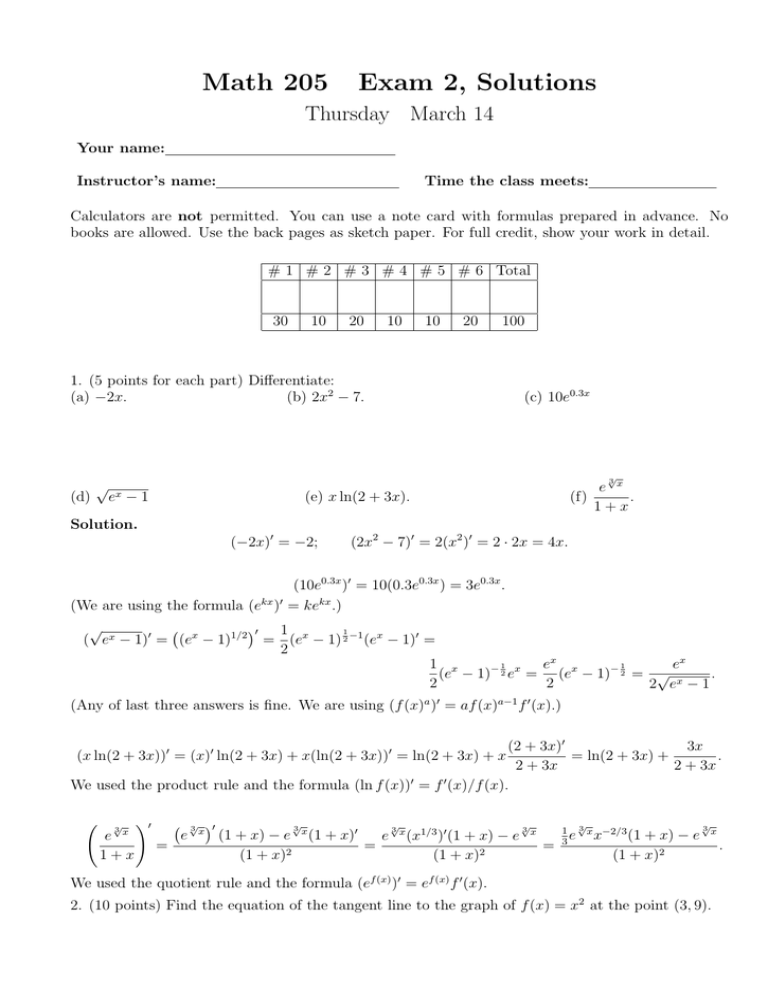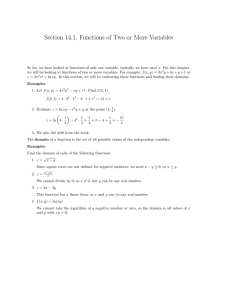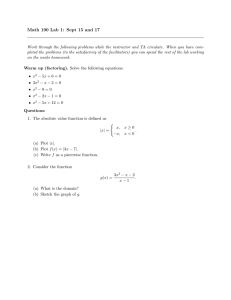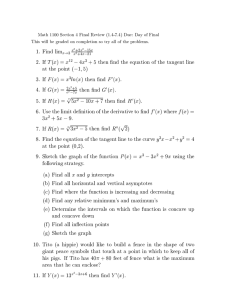Math 205 Exam 2, Solutions
advertisement

Math 205 Exam 2, Solutions Thursday March 14 Your name: Instructor’s name: Time the class meets: Calculators are not permitted. You can use a note card with formulas prepared in advance. No books are allowed. Use the back pages as sketch paper. For full credit, show your work in detail. # 1 # 2 # 3 # 4 # 5 # 6 Total 30 10 20 10 10 20 100 1. (5 points for each part) Differentiate: (a) −2x. (b) 2x2 − 7. (d) √ (c) 10e0.3x √ 3 ex − 1 e x (f) . 1+x (e) x ln(2 + 3x). Solution. (−2x)′ = −2; (2x2 − 7)′ = 2(x2 )′ = 2 · 2x = 4x. (10e0.3x )′ = 10(0.3e0.3x ) = 3e0.3x . (We are using the formula (ekx )′ = kekx .) √ ( )′ 1 1 ( ex − 1)′ = (ex − 1)1/2 = (ex − 1) 2 −1 (ex − 1)′ = 2 1 1 1 x ex ex . (e − 1)− 2 ex = (ex − 1)− 2 = √ x 2 2 2 e −1 (Any of last three answers is fine. We are using (f (x)a )′ = af (x)a−1 f ′ (x).) (2 + 3x)′ 3x = ln(2 + 3x) + . 2 + 3x 2 + 3x We used the product rule and the formula (ln f (x))′ = f ′ (x)/f (x). (x ln(2 + 3x))′ = (x)′ ln(2 + 3x) + x(ln(2 + 3x))′ = ln(2 + 3x) + x ( √ 3 e x 1+x )′ ( = e √ 3 ) x ′ (1 + x) − e (1 + x)2 √ 3x (1 + x)′ = e √ 3x (x1/3 )′ (1 + x) − e (1 + x)2 √ 3x = √ 1 3 x −2/3 e x (1 3 + x) − e (1 + x)2 √ 3 x We used the quotient rule and the formula (ef (x) )′ = ef (x) f ′ (x). 2. (10 points) Find the equation of the tangent line to the graph of f (x) = x2 at the point (3, 9). . 2 Solution. We have f ′ (x) = 2x and f ′ (3) = 6. Thus the tangent line has slope 6 and its equation is y = 6x + b. To find b, we plug in x = 3—we must get y = 9. This means we get an equation 9 = 6 · 3 + b, whence b = −9. Answer: y = 6x − 9. 3. (20 points) The graph of a function y = f (x) is given below y 1 1 x (a) Estimate f ′ (−3), f ′ (−2), f ′ (1). Solution. f ′ (−3) ≈ 1, f ′ (−2) ≈ 0, f ′ (1) ≈ −2. (b) Sketch the graph of f ′ (x) on the same picture. (c) List the critical points of f (x). Solution. The critical points are the points at which the tangent line is horizontal. So they are approximately x = −2 and x = 2.5. (d) List the intervals on which f (x) is increasing. Solution. f (x) is increasing for −4 < x < −2 and for 2.5 < x < 4. 4. (10 points) The weight, W , in lbs, of a child is a function of its age, a, in years, so W = f (a). (a) What are the units for f ′ (a)? The units for f ′ (a) are lbs/year. (b) Interpret the statements f (8) = 45 and f ′ (8) = 4. This means that an 8-year old child weighs 45 lbs and is growing at a rate of 4 lbs/year. (c) Estimate f (7) and f (10). Solution. We have f (7) ≈ f (8) − f ′ (8) = 45 − 4 = 41. f (10) ≈ f (8) + 2f ′ (8) = 45 + 8 = 53. 5. (10 points) (a) The cost C (in dollars), to produce g gallons of a chemical is given by a cost function C(g). If C(10) = 100 and the marginal cost is M C(10) = 5, estimate C(11) and C(8). Solution. C(11) ≈ C(10) + M C(10) = 100 + 5 = 105. C(8) ≈ C(10) − 2M C(10) = 100 − 2 · 5 = 90. (b) If the production level is g = 10 and the marginal revenue is M R(10) = 6 should the company increase the production level? Why? 3 Solution. If the company increases the production level, say, by 1 gallon, the cost will increase approximately by M C(10) = 5 and the revenue will increase approximately by M R(10) = 6. Since the increase in revenue is greater than the increase in cost, the company should increase the production level. 6. (5 points for each part) Let f (x) = x3 − 12x + 5. (a) Find f ′ (x). f ′ (x) = (x3 )′ − 12(x)′ = 3x2 − 12. (b) Find f ′′ (x). f ′′ (x) = (3x2 − 12)′ = 3 · 2x = 6x. (c) Find the critical points of f (x). Solution. We solve the equation 3x2 − 12 = 0 or 3x2 = 12. Dividing by 3, we get an equation x2 = 4. Whence √ x = ± 4 = ±2. There are two critical points: x = −2 and x = 2. (d) Use the second derivative test to classify the critical points (that is, for each critical point decide whether it is a maximum, a minimum, or neither). Solution. We have f ′′ (−2) = 6 · (−2) = −12 < 0. Thus f (x) attains a local maximum at x = −2. On the other hand, f ′′ (2) = 12 > 0, so f (x) attains a local minimum at x = 2.


![Homework 12: Due Wednesday 7/9/14 on the interval [−1, 2]?](http://s2.studylib.net/store/data/011229144_1-0554531fc36f41436ee2a5dab6cfe618-300x300.png)


